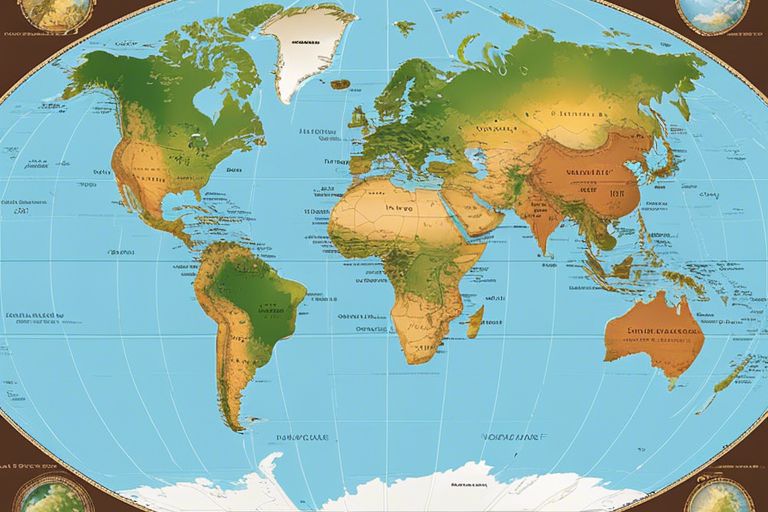Welcome to our latest blog post, where we delve into the intriguing topic of climate zones. Our planet is home to a wide range of environments, from scorching deserts to frozen tundra, each with its own unique set of conditions and challenges. Understanding these diverse climate zones is crucial in order to comprehend the impact of climate change, as well as to navigate and thrive in these environments. In this post, we will explore the different climate zones, their defining characteristics, and the crucial role they play in shaping our planet’s biodiversity and ecosystems. Whether you’re a student, a nature enthusiast, or simply curious about the world around you, this post will provide valuable insights into the complex and fascinating world of climate zones.
Key Takeaways:
- Climate zones categorize the diverse environments of our planet based on temperature, precipitation, and other meteorological factors.
- Understanding the different climate zones is crucial for predicting weather patterns, planning agriculture, and conserving ecosystems.
- Climate change is affecting the boundaries and characteristics of climate zones, leading to shifts in ecosystems and weather patterns.
The Tropics
Obviously, the tropics are a vital part of the Earth’s climate system, covering the region between the Tropic of Cancer and the Tropic of Capricorn. This area is known for its warm temperatures, high humidity, and distinct wet and dry seasons.
Characteristics of Tropical Climates
To understand the tropics, it is important to note that these regions experience high temperatures year-round, with average temperatures of 25°C or higher. The distinct wet and dry seasons are caused by the movement of the Intertropical Convergence Zone, which brings heavy rainfall during the wet season and drier conditions during the dry season.
The high humidity in tropical climates is a result of the warm temperatures and abundant rainfall, creating ideal conditions for lush vegetation and diverse ecosystems.
Major Tropical Ecosystems
The tropics are home to major ecosystems such as tropical rainforests, tropical savannas, and tropical deserts. The tropical rainforests are known for their incredible biodiversity, with a wide variety of plant and animal species, while tropical savannas are characterized by grasslands dotted with scattered trees. Tropical deserts, on the other hand, have adapted to the arid conditions with unique plant and animal species that thrive in extreme heat and limited rainfall.
In the Tropics, the major ecosystems support a wide range of biodiversity, including lush rainforests, vast savannas, and unique desert ecosystems. These diverse environments are home to countless plant and animal species, making the tropics a crucial part of our planet’s biodiversity.
Temperate Zones
While our planet is incredibly diverse, there are certain climate zones that play a significant role in shaping the environment and ecosystems. One of these important climate zones is the temperate zone, which encompasses a large portion of the Earth’s surface and is home to a wide variety of flora and fauna.
Defining the Temperate Climate
The temperate climate is characterized by four distinct seasons: spring, summer, autumn, and winter. This means that the region experiences moderate temperatures throughout the year, with warm summers and cool winters. The temperate zone is situated between the tropics and the polar regions, and it is known for its diverse range of habitats, including deciduous forests, grasslands, and Mediterranean-type ecosystems.
Diversity within Temperate Regions
To understand the complexity of temperate regions, it’s important to note that there are different types of temperate climates around the world. In North America, for example, the temperate zone includes areas with humid continental climates, whereas in Europe, there are maritime temperate climates. These variations lead to a wide range of vegetation and wildlife that have adapted to the specific conditions of each region.
It is fascinating to note that the temperate zone is not only home to a diverse range of habitats, but also to a rich array of species. From the majestic oak trees of the deciduous forests to the unique wildlife of the grasslands, the temperate zone boasts an incredible level of biodiversity. However, it is important to recognize that the temperate zone is also facing significant threats from climate change and human activities, which are endangering the delicate balance of this crucial ecosystem.
Polar and Subpolar Regions
To understand the diverse environment of our planet, it is essential to explore the polar and subpolar regions. These regions, located near the North and South Poles, are characterized by extreme cold temperatures and unique ecosystems.
Life in Extreme Cold
Regions in the polar and subpolar zones are home to a variety of wildlife that have adapted to survive in the extreme cold. Animals such as polar bears, arctic foxes, and penguins have developed thick layers of fat or blubber, as well as specialized fur or feathers, to insulate themselves from the freezing temperatures. Additionally, many species in these regions have unique hunting and foraging behaviors to find food in a challenging environment.
The Impact of Climate Change on Polar Zones
One of the most urgent issues affecting the polar and subpolar regions is the impact of climate change. As global temperatures rise, polar ice caps and glaciers are melting at an alarming rate, leading to rising sea levels and the loss of vital habitat for polar animals. The melting ice also disrupts the delicate balance of the ecosystem, affecting the availability of food and resources for both wildlife and indigenous communities.
Life in the polar and subpolar regions is facing significant threats due to the impact of climate change, with species such as polar bears and seals at risk of extinction. The loss of sea ice and changes in the availability of prey can have devastating effects on these animals, as well as on the communities that rely on them for their livelihood. It is crucial to take immediate action to mitigate the effects of climate change and protect the fragile ecosystems of the polar and subpolar zones.
Arid and Semi-Arid Climates
Now let’s delve into the unique characteristics of arid and semi-arid climates and the challenges and adaptations associated with these environments.
The Challenge of Dry Lands
For regions classified as arid or semi-arid, the primary challenge lies in the scarcity of water. This scarcity is a result of low precipitation levels and high evaporation rates, making it difficult for vegetation to thrive. The intense heat and lack of moisture also contribute to soil erosion, desertification, and a limited capacity to support agriculture and other human activities.
Additionally, the limited availability of drinking water poses a significant risk to both human and animal populations, leading to water scarcity and potential conflicts over access to this vital resource.
Adaptations and Human Interactions
Lands characterized by arid and semi-arid climates have led to the development of unique adaptations by both plant and animal species. These adaptations include deep root systems, water storage capabilities, and specialized metabolic processes that allow for survival in these harsh environments. Humans have also developed strategies to cope with these conditions, such as the implementation of water conservation techniques, the use of drought-resistant crops, and the establishment of nomadic or semi-nomadic lifestyles.
Plus, some cultures have integrated sustainable practices, such as traditional water harvesting methods and the construction of efficient irrigation systems, to maximize the use of limited water resources and mitigate the impact of droughts and water scarcity.
Climate Zones – Understanding The Diverse Environment Of Our Planet
Q: What are climate zones?
A: Climate zones are large areas of the Earth that share similar weather patterns and climate conditions. These zones are determined by factors such as temperature, precipitation, and vegetation, and play a crucial role in shaping the natural environment and ecosystems.
Q: How many climate zones are there?
A: There are generally five primary climate zones: Tropical, Dry, Temperate, Continental, and Polar. Each zone has its own unique characteristics and is defined by specific climate patterns and environmental features. Within these primary zones, there are also numerous subcategories and variations based on factors such as altitude and proximity to water bodies.
Q: Why is it important to understand climate zones?
A: Understanding climate zones is essential for a variety of reasons. It helps us comprehend the distribution of plant and animal species, agricultural practices, and natural resources. Additionally, it enables us to predict and prepare for weather patterns and extreme events such as hurricanes, droughts, and heatwaves. By understanding climate zones, we can also make informed decisions about conservation, land use, and sustainable development.



